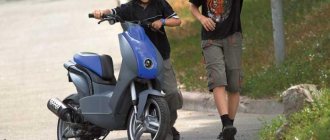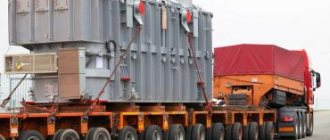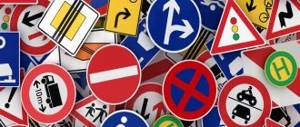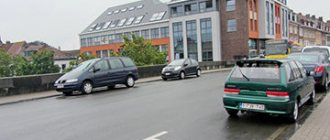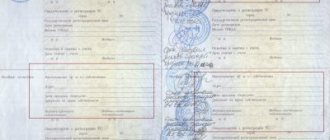Can I transport my child in a booster seat - quick test
1. What is the age range of your child?
Less than 7 years 7-11 years 12 or more years
2. Does the booster have one of the following markings on the body or a corresponding certificate in the form of a document: “UNECE No. 44-04”, “GOST R 41.44-2005” or “ECE R44/04”
Not really
2. Does the booster have one of the following markings on the body or a corresponding certificate in the form of a document: “UNECE No. 44-04”, “GOST R 41.44-2005” or “ECE R44/04”
Not really
You can transport your child simply by fastening him with a standard seat belt. But if the top strap of the seat belt goes over the child's neck, it is recommended to place him in a booster seat or child car seat. Go through again
You can transport your child simply by fastening him with a standard seat belt, only in the back seat of the car. But if the top strap of the seat belt goes over the child's neck, it is recommended to place him in a booster seat or child car seat. Can be transported in the front seat in your certified booster seat. Go through again
You can only transport your child in a booster seat or child car seat that meets the above requirements. Go through again
You need another booster certified according to the specified Rules. Your current booster is unsafe and you may get a fine if you use it. Go through again
You can transport your child simply by fastening him with a standard seat belt, only in the back seat of the car. But if the top strap of the seat belt goes over the child's neck, it is recommended to place him in a booster seat or child car seat. You cannot carry a child in the front seat, as this can only be done in a certified booster or car seat, but your current booster is not certified, is unsafe and you can get a fine if you use it. Go through again
What do the 2021 traffic rules say?
The last time the Rules were adjusted regarding the issue of transporting children and boosters, in particular, was in July 2021. And then clause 22.9, which regulates the rules of transportation, became even more confusing. There is no specific mention of any device:
- no child seat
- no booster in the context of the child’s age,
- nor any kind of adapters or other devices.
There are only two common vague terms:
- child restraint,
- child restraint system.
At the same time, it is not said whether these are the same thing or different devices for transporting children.
22.9. Transportation of children under the age of 7 years in a car and truck cab, which are designed with seat belts or seat belts and an Isofix child restraint system, must be carried out using child restraint systems (devices) that are appropriate for the weight and height of the child.
The name of the ISOFIX child restraint system is given in accordance with the Technical Regulations of the Customs Union TR RS 018/2011 “On the safety of wheeled vehicles”.
Transportation of children aged 7 to 11 years (inclusive) in a passenger car and truck cab, which are designed with seat belts or seat belts and an ISOFIX child restraint system, must be carried out using child restraint systems (devices) that are appropriate for the weight and height of the child , or using seat belts, and in the front seat of a car - only with the use of child restraint systems (devices) corresponding to the weight and height of the child. The installation of child restraint systems (devices) in a passenger car and the cabin of a truck and the placement of children in them must be carried out in accordance with the operating instructions for the specified systems (devices).
It is prohibited to transport children under the age of 12 on the back seat of a motorcycle.
So, we see that there is a gradation according to the child’s age and rules for transportation in the back and front seat of a car:
- up to 7 years - both in front and behind only using child restraints,
- from 7 to 11 years old - only with child restraints in front, can be fastened with a seat belt in the back,
- From 12 years old you can wear a seat belt.
You will also be interested in:
- Can frameless child car seats be used in a car? From what age?
- Fines for violations of the rules for transporting passengers in situations
- A child in the front seat - at what age can you drive under the new law?
How to choose a booster
When choosing a child booster, it is necessary, first of all, to focus on the safety, reliability and comfort of placing a child in the cabin.
Frame material
The frame material is hard: metal or plastic. In this case, the following conditions must be met:
- the pillow filler should be soft and hold the shape of the body;
- the surface of the seat should be evenly covered with ergonomic filler;
- The leading edge of the booster should be soft and sloping.
In addition, there are no obvious frame protrusions around the entire perimeter of the device that would impact a child under normal conditions.
Case material
Preferred characteristics of the cover material: wear resistance and hypoallergenicity. The use of natural fabrics that do not cause sweating and are able to absorb moisture increases the child’s comfort in hot weather. The removable cover guarantees timely cleaning and washing.
Armrests
The metal frame of the armrests should be covered with soft filling to create comfort. To reduce the risk of injury, the only condition must be met: the height of the armrest must correspond to the free position of the child’s arm, bent at a right angle.
Dimensions
The overall dimensions of a booster seat for children must correspond to the size of the child, since this is the basis for safe transportation:
- The length of the seat should be equal to the length of the legs with bent knees with full contact between the child’s back and the back of the car seat. If the length of the booster is longer, the child’s legs will be straightened, which is contrary to safety conditions. In addition, by bending his legs, the child will roll his back along the back of the car seat, which will lead to the seat belt moving from the shoulder to the neck or head - this position is strictly unacceptable. A similar situation will arise if the length of the seat is shorter - the lack of comfort will encourage the child to slide down the back.
- The width of the booster should correspond to the size of the child, taking into account the presence of warm clothing. Squeezing the body will cause pain, and the presence of free space will not allow you to securely fix the position.
Thus, before purchasing, it is advisable to place the child on the booster and check the compatibility of the sizes.
Seat belt corrector
The corrector is used to prevent the seat belt from moving in the event of an emergency. It is a triangular envelope that pulls two standard belts together. Required when the belt strap slips off the child’s shoulder and does not return spontaneously.
It can be used in extreme cases as an additional measure in conjunction with a booster, but is not an independent restraint device, since it shifts the calculated load on the belt and weakens its tension.
Mounting method
The safest way to secure a child booster seat in the cabin is the ISOFIX or LATCH system. It is certified and allows you to securely fix the booster on the car seat.
It is allowed to place the booster in the cabin using seat belts without additional fastening, however, this significantly increases the risk of injury in the event of an emergency.
Child's opinion
The child’s opinion is an important factor when choosing a booster, since only he himself will identify possible inconveniences in use:
- the presence of protruding parts of the frame;
- hardness or excessive softness of the seat;
- squeezing on the sides.
In addition, during testing it is necessary to check the compliance of the armrests and seat length with the child’s size, and also to identify the need to adjust the seat belt.
Can a booster be used at what age of a child?
Let's return to our main question about the possibility of placing a child in a booster seat - at what age can this be done according to traffic rules in 2021? To answer, we need to understand what a booster is by law. And the Rules refer us to the Technical Regulations.
Looking at the latter, we understand that the child restraint system must comply with UNECE Regulations No. 44-04 (Appendix No. 10 - “List of requirements for types of vehicle components”). If your booster meets these requirements, then you can transport your child in the booster.
Finding out about such compliance is quite simple: there should be a corresponding marking on the label on the booster itself. In this case, 2 options for representing the notation are possible:
- Russian-made boosters are, as a rule, marked “UNECE No. 44-04” or “GOST R 41.44-2005” (the latter GOST is the Russian version of the UNECE Rules),
- Imported boosters are most often marked as “ECE R44/04” - this also means that the device meets the requirements of the Economic Commission for Europe.
Boosters with this marking can transport children of any age. In very rare cases, boosters may not have any markings on the case at all, but only in the documents. In this case (and in general always), when purchasing, you should request a certificate of compliance with the above rules. Otherwise, you may be legally fined.
Expert opinion
Yuri Panchenko
Driving instructor, human rights activist, author of books. 10 years of experience.
As correctly stated in the article, the requirements for child restraints are regulated by UN Regulation No. 44-04.
GOST R 41.44-2005 has lost force since 01/01/2018, but if the child seat indicates the date of manufacture before the specified date, and there is a plate of compliance with GOST R 41.44-2005, then there should be no claims from the traffic police.
The use of boosters is governed only by UN Regulation No. 44-04. They must also have a conformity label. Moreover, the booster must be manufactured after 02/09/2017, when the relevant amendments entered into force. This device is used for children with a height of 125 to 150 cm and a weight of 22 to 36 kg.
If a child is taller than 150 cm or weighs more than 36 kg, then there are no child restraints for him. Then we fasten the child with a regular standard seat belt in the back seat.
Ask a Question
Does it matter what the booster is made of?
Boosters come in foam, plastic and metal frames.
• Foam boosters are the least expensive, weigh very little, but are less safe than other types.
• Plastic boosters are also quite lightweight. This is a universal option for trips and travel: a worthy compromise in price and quality.
• Boosters with a metal frame are the most durable and safest. However, the metal parts are quite heavy, which affects the overall weight of the product. And the dimensions of such a booster are larger: a good option for constant use in your car.
At what age can you travel without a booster?
The answer to this question is already clearly given to us by the 2021 traffic regulations:
- if the child is under 7 years old, then he can only be transported in a child booster seat or seat (in compliance with the latest UNECE rules No. 44-04),
- from 7 to 11 years old, children can be transported without boosters at all in the rear seats, and only in a booster or child seat in the front seat,
- From the age of 12, a child can ride, fastened only with a standard seat belt, in any seat.
You can, but you don't need to!
It should be borne in mind, however, as we have already mentioned above, that no fine can logically take precedence over the safety of children. And it’s not for nothing that the traffic rules mention the compliance of a child restraint system with the child’s height and weight.
The fact is that for many children over 7 years old, when they can be transported without a booster according to the Rules, the standard belt (top strap) runs exactly along the neck. This should not be allowed, since in an accident the risk of fatal injury is even higher than if the child were driving unbelted. To confirm this, you can watch the very first crash test video of the dummy below.
Therefore, the issue must be approached strictly individually - most often it is still recommended to use a booster seat or a child seat, regardless of how old the child is and whether this is in compliance with the traffic rules.
Also, if the Rules allow you to transport a child without a booster, but you use it for safety reasons, then the booster’s compliance with the rules is no longer critical for compliance with the law (but they still mean that the booster has passed the necessary tests and is safe for your child).
Something else useful for you:
- We drove under the camera at a yellow traffic light: will there be a fine and how to appeal?
- Is there a fine for driving on summer tires in winter and winter tires in summer today? What date will it start?
- Traffic regulations about passing a stationary car on a continuous road: what is the fine and is it possible to cross?
Types of child restraints
What is meant by the definition of "child restraint"? This category includes:
- car seat,
- booster,
- frameless car seat.
Having a child restraint system in your car is not just a formality, but a guarantee of your baby’s safety. Let's figure out why a child under 12 years old cannot be seated like an adult passenger.
The standard seat belt is three-point. It has two sections: lumbar and shoulder. The minimum height of the passenger for which it is designed is 150 cm. If you fasten a child under 150 cm tall, the belt strap will not fit correctly - the upper one will slide to the neck, and the lower one will lie on the thigh. In the event of an accident, the belt can damage the fragile neck and cause serious injury to the abdominal organs.
Having a child restraint system in your car is not just a formality, but a guarantee of your baby’s safety.
It is also unacceptable to hold a child in your arms while moving and sit him on an adult’s lap. The fact is that even in a low-speed collision, the force of inertia increases the passenger’s body weight tens of times. Even a real strongman cannot hold a baby in his arms. In this situation, the child either flies forward or finds himself crushed by the body of an adult.
Child car seat restraint system
Depending on the weight and age of the child, car seats are divided into several main groups. Each of them takes into account the characteristics of its age category, which makes it possible to protect the little passenger as much as possible and make his trip comfortable.
Modern models of car seats are distinguished by the anatomical shape of the seat, which makes the baby feel comfortable. The design of many models includes comfortable armrests and footrests. Many manufacturers also offer a number of useful accessories to improve your travel comfort.
You will always see a special compliance symbol on a certified car seat. It is a circle in which the letter E is inscribed, as well as numbers indicating the country of certification and the series number of the current standard.
Booster restraint for children
A car booster seat is a child restraint device designed for passengers aged 3 to 12 years.
A car booster seat is a child restraint device designed for passengers aged 3 to 12 years.
It is a small seat with armrests without a backrest and internal seat belts. The child is fastened with a standard seat belt in the same way as an adult. The booster's job is to raise the baby's body so that the standard seat belt goes correctly - that is, across the chest and not across the neck. The size of the booster is quite compact and lightweight.
The booster is recommended for children whose height is at least 120-130 cm. If the baby is not yet tall enough, then it is necessary to ride in a regular car seat, otherwise the child’s back will not have sufficient support and fixation.
As for weight, the initial threshold is 15 kg. These two parameters need to be considered together. A child can weigh 15 kg even at three years old, while his height will still be far from normal.
Retaining device frameless car seat for a child
A children's frameless car seat is a restraint device that is shaped like a chair, but does not have a rigid frame. It is attached with special straps to a standard car seat. There are soft inserts in the head, back and pelvis areas to increase the comfort of the ride. The standard seat belt is also used - it goes across the front of the seat, fastening the small passenger.
Restraint: child adapters
The minimum height of a passenger for which a standard seat belt is designed is 150 cm. If you fasten a child in the passenger seat as an adult, the strap will lie incorrectly, namely, in the immediate vicinity of the neck, which threatens serious injuries even in a minor accident. In order to correct the situation, standard seat belt adapters were invented - special pads that “lower” the three-point belt to the desired level, allowing the child to ride without a car seat.
What is the penalty for incorrect transportation in a booster?
The fine for violations of the rules for transporting children for 2021 is general - it is 3,000 rubles under Part 3 of Article 12.23 of the Administrative Code. It will be issued to you if:
- You are transporting a child under 7 years of age in a vehicle without a booster seat or any other approved child restraint device,
- You are transporting a child from 7 to 11 years old in the front seat without these same devices,
- You are transporting an unbelted child over 12 years old,
- the child is sitting in the booster seat, but is not fastened or the booster itself is not fastened (in cases where this is provided for by the design of the booster itself).
This fine can be paid with a 50% discount during the first 20 days after the decision is issued (and later in some cases). The cameras do not record this traffic violation, and evacuation to the impound lot is not provided.
The peculiarity of this fine lies in two important subtleties:
- it can be prescribed every time the car starts moving (even by the same inspector), no days for elimination,
- If you are transporting 2 or more children without a booster or with other violations of the transportation rules, then only one fine should be assigned per stop, since the very fact of violating the transportation rules is punished specifically.
Expert opinion
Dmitry Tikovenko
Automotive law expert. 7 years of experience. Areas of specialization: civil law, disputes over compulsory motor liability insurance and road accidents
This article will be of interest not only to young mothers and fathers, but also to those who transport children for official reasons. We are talking about taxi drivers.
If you violate the rules for transporting children when providing transportation services in a taxi, then the driver will not get away with simply fines from the Administrative Code. This act can already be qualified as the provision of services that do not meet safety requirements, which means that the driver will be held accountable under another article and even under another code - criminal. In the code, this is Article 238, and the punishment here can be either a fine or imprisonment.
Ask a Question
Description of the starting device
What is this engine starting system, how does the module work and what is its purpose? Let's look briefly at these questions.
Purpose and functions
The purpose of the car charging unit is to ensure better engine starting. Such a need may arise in different cases, but as practice shows, our compatriots usually face such a problem precisely in cold weather. In addition, most modern charging modules also allow you to charge mobile gadgets - tablets, smartphones and other devices. They even have additional ports for this purpose.
Starting device Feeder 900
Design and principle of operation
There are several types of charging modules:
- Pulse blocks, the operating principle of which is based on pulse voltage conversion. In such a module, the voltage first increases under the influence of the current frequency, after which it decreases and is converted. Such devices are usually characterized by low power and, as a rule, are used to recharge a discharged battery. But if the battery charge is very low, and it is frosty outside, then in this case, recharging the battery may take quite a long time. The main advantages of such blocks include low price, light weight, and compact size. As for the disadvantages, this is the low power of the module, as well as the difficulty of its repair, especially since, as practice shows, they can often fail due to unstable voltage.
- Transformer units - in this case, the main element of the device is a transformer, which is used to convert current into voltage. Such charging modules allow you to increase the charge of any battery, regardless of its discharge, even if it is almost full. In addition, devices of this type are immune to voltage surges; they can operate in any condition. The main advantages include the power of the modules and their reliability, as well as their unpretentiousness in terms of operation. As for the disadvantages, it is high cost, large size and weight.
- Boosters are another type of block. A booster is a portable battery that operates on the principle of a portable unit - first, the booster charges the battery, and the power unit is started from the battery. Boosters can be household or professional; they differ in volume and size. In household boosters, the capacity is quite low, but it is usually enough to start one engine. Professional devices are full-fledged chargers that can start several cars, and the on-board network in such cars can be either 12-volt or 24-volt. The advantage of boosters is their compactness and autonomy, however, due to their size, they can only be installed on flat surface.
- Capacitor modules. In this case, the procedure for starting the motor is carried out according to a rather complex principle; the circuitry of such devices is based on powerful capacitor devices. First of all, they are charged, after which the capacitors transfer the charge to start the motor. Capacitors charge quite quickly and just as quickly they release their charge to start the internal combustion engine. As a result of the fact that the cost of such modules is quite high, they are not so popular. Moreover, in practice, their frequent use can lead to accelerated wear of the battery (the author of the video is the carpow carpow channel).
About FEST adapters
While discussing the booster, we should also mention various types of adapters for children, the most common of which is FEST. And it has recently been banned for use on the territory of the Russian Federation. The ban was established by Rosstandart as not complying with the same EEC rules, although FEST formally assures that their adapters still meet these requirements.
Meanwhile, various tests of FESTs have long shown their danger in road accidents - mainly the traumatic effect on the child’s abdominal cavity.


